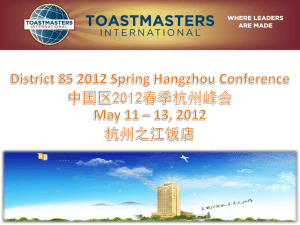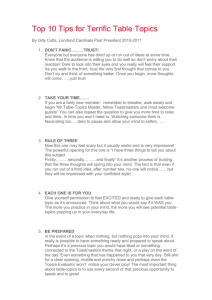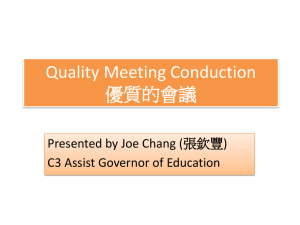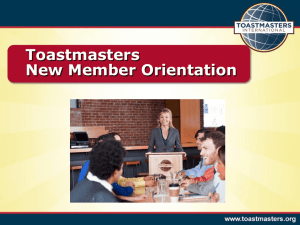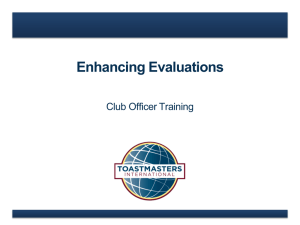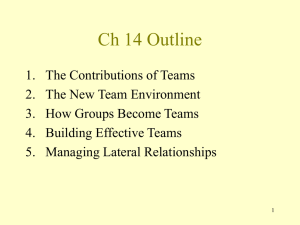motivating people - Boaters Toastmasters Christchurch
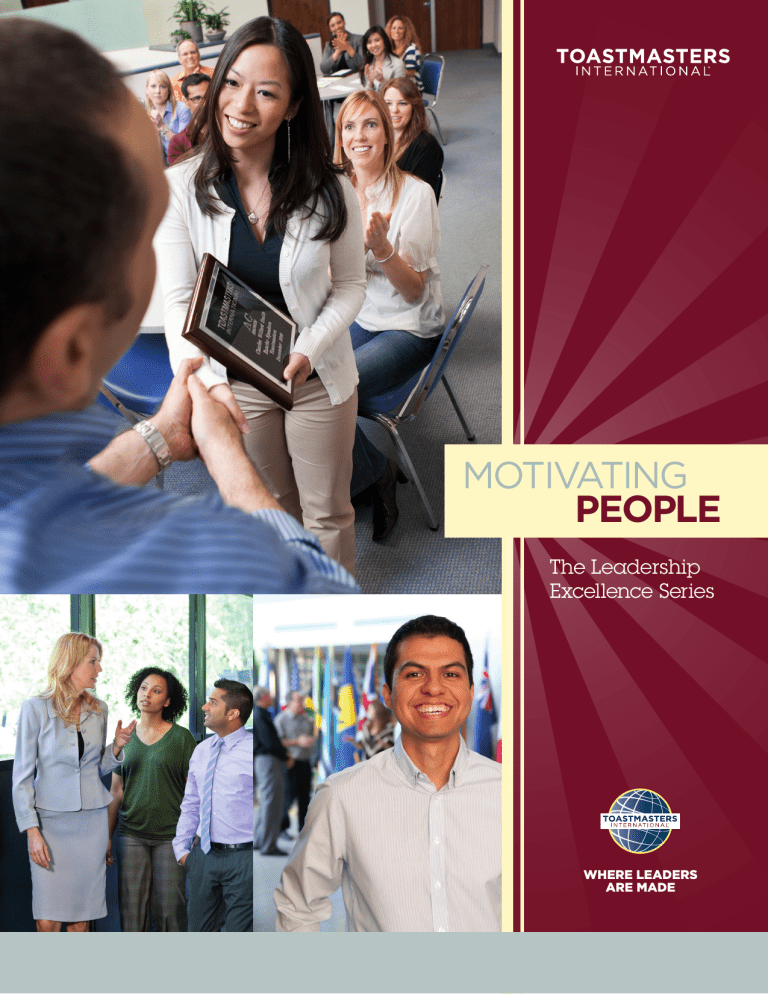
MOTIVATING
PEOPLE
The Leadership
Excellence Series
WHERE LEADERS
ARE MADE
MOTIVATING
PEOPLE
TOASTMASTERS INTERNATIONAL
P.O. Box 9052 • Mission Viejo, CA 92690 • USA
Phone: 949-858-8255 • Fax: 949-858-1207 www.toastmasters.org/members
© 2011 Toastmasters International. All rights reserved. Toastmasters
International, the Toastmasters International logo, and all other
Toastmasters International trademarks and copyrights are the sole property of Toastmasters International and may be used only with permission.
Rev. 5/2011 Item 319A
The Leadership
Excellence Series
THE LEADERSHIP EXCELLENCE SERIES
Toastmasters International’s The Leadership Excellence Series is a set of presentations addressing the subject of leadership. Members will learn about the skills they will need to be successful leaders inside and outside of Toastmasters.
Presentations in The Leadership Excellence Series may be offered by any club member and require 10 to 15 minutes to present.
CONDUCTING THE PRESENTATION
“Motivating People” discusses how to create and maintain an environment in which team members will become motivated. This product consists of four parts:
Definition and explanation of the presentation
Guidelines for your introduction to the audience
Outline for the development of your speech
CD of a PowerPoint presentation to be viewed along with your speech
In Your Own Words
The outline is not a script and should not be read word-for-word. Instead, use the document as a guide for presenting the material in your own words and with your own narrative style. The outline is a structure on which to build your presentation.
Use the points of the outline to develop your speech, but be the author of your own oration.
Here are some tips on using this outline to develop and deliver your presentation:
Study the outline carefully. Familiarize yourself with the general structure. Preparation is the key to a successful presentation.
Use the outline to build your own speech using your own words. Prepare a set of notes indicating where you wish to pause, gesture, or add special verbal emphasis. Highlight key words or sentences to help you present the material most effectively.
Be expressive when delivering your speech. Use all of the presentation skills you have learned as a Toastmaster including vocal variety and gestures.
USING VISUAL AIDS EFFECTIVELY
Visual aids add interest to any presentation and help your audience retain information. You are encouraged to use them. If you plan to use the PowerPoint slides for this presentation as visual aids, you will need a data projector, a laptop computer, a table to support them, and a screen for viewing. In the outline, there are indications for placement of the PowerPoint slides. Each is numbered.
For example, V1 refers to the first visual.
Please note that the first slide in the PowerPoint show is a title slide and is not included in this numbering system.
2 THE LEADERSHIP EXCELLENCE SERIES • MOTIVATING PEOPLE
If you cannot arrange for projection equipment but still would like to use visuals, you may copy the material on the visuals onto a flipchart. Do this before the presentation. Use a heavy marking pen that does not seep through the paper, and write on every third or fourth page so succeeding visuals will not show through. Also, make your letters large and heavy with plenty of space between them.
Follow these tips when using visual aids:
Set them up and test them before the meeting begins. Place them so they are easily visible to listeners. Place your projector so it projects a large, high, undistorted image on the screen.
Focus the image.
Bring spare equipment, including a projector bulb, extension cord, extra marking pens, etc.
Display your visuals only when they are needed. If you are using a flipchart, flip the page back out of view when you are finished with it.
Remember not to stand between the screen or flipchart and your audience or you will block their view.
Maintain eye contact with your listeners. Do not talk to the screen or flipchart. If you must turn your back to point out something, pause as you point it out, and then resume speaking only after you are once again facing your audience.
EVALUATION AND THE ADVANCED LEADER BRONZE (ALB) AWARD
Because this is an outlined presentation, for presenting it you will not receive credit toward completing a manual speech project, but you may receive credit toward your Advanced Leader Bronze
(ALB) award. Ask your vice president education to assign an evaluator for your presentation.
Conducting any two presentations from The Successful Club Series and/or The Leadership
Excellence Series is one component of qualification for ALB recognition. For further details, please view the Toastmasters International website: www.toastmasters.org/membereducation.
THE LEADERSHIP EXCELLENCE SERIES • MOTIVATING PEOPLE 3
MOTIVATING PEOPLE
Introducing the Presenter
TIPS FOR THE PRESENTER: WRITE YOUR INTRODUCTION
All prepared speeches in Toastmasters require an introduction. A proper introduction of you and your speech is important to the success of your presentation. Use the following as a guide in writing your introduction:
Include the purpose of The Leadership Excellence Series .
Explain why “Motivating People” is important for a Toastmasters club, stating the purpose and one or more objectives of your presentation.
Incorporate some background about yourself.
Read When You’re the Introducer (Item 1167E) for further details on giving a proper introduction.
Give your finished introduction to the person who will be introducing you.
TIPS FOR THE INTRODUCER
Ask the presenter any clarifying questions.
Rehearse the introduction.
4 THE LEADERSHIP EXCELLENCE SERIES • MOTIVATING PEOPLE
MOTIVATING PEOPLE
Outline
INTRODUCTION
Motivating people is a complex undertaking. Leaders must understand what motivates team members and then use this understanding to create and maintain an environment where team members have the opportunity to fulfill their personal motives, wants, and desires while contributing to a larger enterprise.
Even though a leader provides the appropriate environment and encourages team members toward motivation, it is the individual who sparks his or her own momentum. But a successful leader understands what these sparks are and uses them to develop reward systems that match team members’ values.
Following are some things that motivate people:
Money
Praise
Public recognition
More responsibility
Promotion
V1
V2
Presenter:
Facilitate a discussion about ways to motivate volunteers. Write ideas on a flipchart.
MATCH SKILLS TO JOBS
Every individual has talents and skills. Part of a leader’s job is to support these skills by directing team members toward jobs that fit their skills. In doing so, the leader further motivates team members by providing the opportunity to use his or her natural skills.
REWARD PROPERLY
Recognizing positive behavior should be done carefully.
Recognize immediately. Reward someone as soon as possible after the achievement.
This encourages repetition of the behavior.
Reward only the desired behavior. Reward only the behavior that you want, and reward only when the person or team performs better than the standard.
Address undesirable behavior. Ignoring poor performance sends the message that it is acceptable and the poor performance will continue. Other team members who do perform well will become discouraged.
V3
V4
THE LEADERSHIP EXCELLENCE SERIES • MOTIVATING PEOPLE 5
V5
Eliminate obstacles. Environmental factors can cause problems for and frustrate a team.
Removing these impediments can create a more positive work environment for the team.
CONCLUSION
When a leader understands what inspires individual team members to perform well and rewards them appropriately, team members will be committed to the leader’s goals and willing to work hard to achieve them.
If your actions inspire others to dream more, learn more, do more and become more, you are a leader.
— John Quincy Adams, Sixth U.S. President
6 THE LEADERSHIP EXCELLENCE SERIES • MOTIVATING PEOPLE
Evaluation Guide
Evaluator’s Name _________________________________________________________________
Presentation Title ________________________________________ Date _____________________
How effective was the speaker’s introduction in helping the audience understand the purpose of
The Leadership Excellence Series and the presentation itself?
Was the presenter adequately prepared? How heavily did the presenter rely on notes?
How did the speaker use vocal variety to enhance this presentation?
What other techniques did the speaker use to personalize and augment the presentation?
Were they effective? How?
Did the speaker display the visuals smoothly and at the appropriate times? How could the speaker improve?
What aspect of the speaker’s presentation style did you find unique? Why?
Did the speaker present the material clearly and simply so audience members could easily use the information to improve their own leadership skills?
What could the speaker have done differently to make the presentation more effective?
What did you like about the presentation?
THE LEADERSHIP EXCELLENCE SERIES • MOTIVATING PEOPLE 7
Notes
8 THE LEADERSHIP EXCELLENCE SERIES • MOTIVATING PEOPLE
